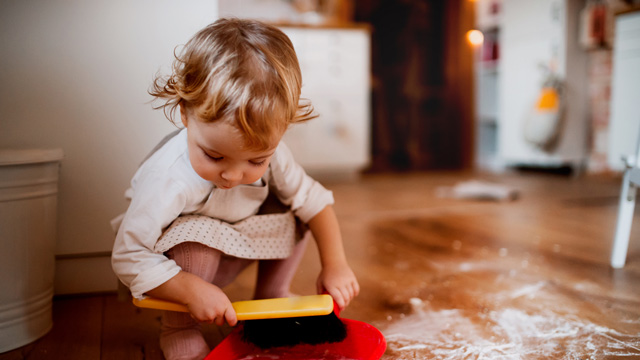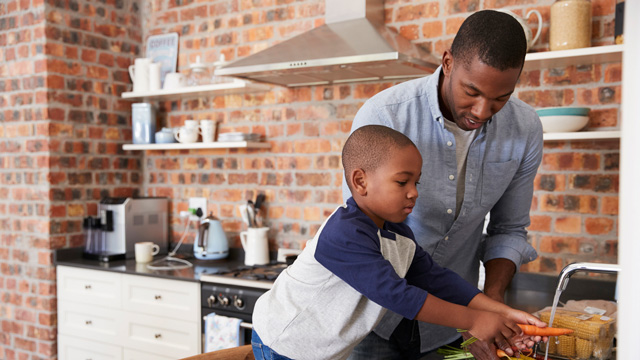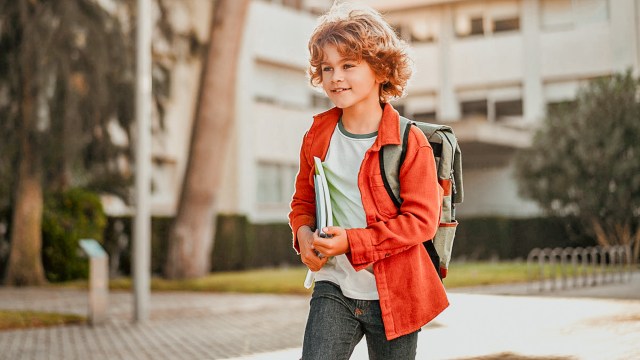Your child says, “I’m hungry,” and you grab them a snack. They say “I’m bored,” and you find a way to entertain them. But when should the butler treatment end? When is it time to teach your child how to be self-sufficient and let them do things for themselves?
Believe it or not—now is as good a time as any! Your two-year-old might just be able to help you do the laundry; your 6-year-old can try brushing her teeth; your older kid can probably hang out alone at home while you walk the dog. And, no matter how desperately they cry, “Watch me!” young kids don’t always need you right there next to them (being nearby is just fine).
That being said, not all children develop at the same speed, and neurodivergent kids or those with disabilities may have a different timeline. So take the exact ages with a grain of salt. The key is to empower each individual kid to take on what works for them and build some independence.
“What you’re really trying to do is get the child to learn how to make decisions and take control over the things they can have control over,” said Dr. Michael Ungar, director of the Resilience Research Center and the author of We Generation: Raising Socially Responsible Kids. “What you really want is a child who can make a contribution to their family, who can navigate their community, who can problem solve.”
Check out our age-by-age guide that ranges from letting your toddler help with household chores to giving your tween tech time—all to help you start to figure out the right time to give your kids that much-needed independence. Here’s what the experts say.
Things Kids Can Do: Ages 0 to 2
Don’t worry: You won’t need to start nudging your one-year-old out of the nest. According to Los Angeles child psychiatrist Patrick Kelly, it’s the opposite: the stronger the attachment between parents and their babies, the more comfortable those kids will be doing things independently as they grow. That said, there are a few “big kid” things your tiny tot can start learning at this age:
Feeding and Dressing Themselves – According to Los Angeles pediatrician Amin Davari, simple things like allowing older infants to feed themselves age-appropriate foods and letting young children dress themselves give kids “minor struggles and successes” that help them learn how to be self-sufficient and build skills and confidence.
Swim Lessons – The AAP recently changed its guidelines to say that kids should start swimming lessons at age one. Although swim lessons will never make a child “drown proof,” lessons between the ages of one to four years have been shown to reduce drowning risk, according to the AAP.
Sign Language – Just because your baby can’t talk doesn’t mean she’s not trying to tell you something. Advocates say teaching babies and toddlers basic signs (things like “eat,” “more” and “milk”) can increase confidence in both the kids and their caregivers, helping little ones who can’t yet speak get their needs met. Taking a class can mean a fun social outing for Mom or Dad—though you can also learn from home.
Things Kids Can Do: Ages 2 to 4

At this age, kids are ready—and willing!—to take on some responsibility around the house. You’ll know the time is right when you see them start pretending to do grown-up things, like playing “family” or play-driving the car when they’re in the push car. Take advantage of this need now by giving them:
Simple Household Chores – Give them a broom or a dustpan, and let them help you sweep the kitchen floor. You’d be surprised how willingly kids this age will want to help you clean. If you’re lucky, the habit will continue into their later years. Other simple household chores suitable for two-to three-year-olds, according to The Montessori Notebook are:
-
- Help pack their backpack
- Brushing/feeding the dog (just let it go when they make a mess!)
- Helping make the bed (at four, kids should be able to at least pull up a duvet by themselves)
- Placing clothing in the laundry and pushing the buttons you point to
Solo Playtime – As long as you’ve created a safe space to play, at this age most kids are generally past the swallowing-small-objects phase and can happily play by themselves for 30 to 45 minutes at a time. If your child is reluctant to play alone, just agree to be nearby, but set up toys with which they can play solo.
“Reading” Time – Your child doesn’t need to know how to read to get lost in a world of books. Give kids a stack of picture books and let them have at it. If they want to hear stories read out loud—but you still want them to be on their own—we love the Yoto player, a simple speaker designed for kids ages three and up that allows kids to insert small cards to read popular stories aloud.
Pick What they Wear – Something as simple as choosing their clothes can make a child feel incredibly independent, says Dr. Ungar. “Three-year-olds can’t negotiate their bedtimes, but they can decide to wear green pajamas or blue pajamas. The trick seems to be to find these ways that the child can make a genuine contribution.”
Use a Balance Bike – Kids may not be ready for a two-wheeler at age two… but a balance bike is an easy go-to! “Once a child can confidently walk around the house, they can start walking with a balance bike between their legs,” says Schwinn spokesperson Ryan Berkicht. “This could be as soon as 18 months old for some kids.”
Things Kids Can Do: Ages 4 to 6
Gross motor skills are advancing quickly at this age, too, so your kids should be ready for fun things like climbing on a play structure (without you constantly spotting), and using the “big kid swing” all by themselves. And while these may seem like ordinary childhood milestones, all of these accomplishments help them learn how to be self-sufficient and instill huge amounts of confidence. So cheer your kids on as they:
Brush Their Teeth: While most dentists advise that you keep assisting with their pearly whites until age 7, your kids should know how to brush their teeth all on their teeth by age 5 or 6—with you nearby to make sure there’s actual brushing going on (as opposed to just holding the electric toothbrush in their mouths while the motor revs). A good compromise is to let your kids do the morning brush and you can brush their teeth in the evening.
Use a Microwave with Supervision – Not only does using the microwave buttons help reinforce number recognition, but it also makes kids feel like real big kids. Teach your kids what can and can’t go in the microwave, and let them push the buttons and press “start” all on their own.
Ride a Two-Wheeler – Sure, some kids are ready for a two-wheeler at three years old—and some five-year-olds want nothing to do with a bike—but experts say age 5 or 6 is a good target age for getting a kid on her first two-wheeler. If they’ve been riding a balance bike or a bike with training wheels, they should be able to transition easily.
Have Drop-Off Play Dates – According to the AAP, kids around ages 5 and 6 are developmentally ready to be dropped off for play dates. Got a child who’s nervous about it? It might help to have the playdates at your house, where you can step away—but not out.
Day Camp – Since this is the age when kids start preschool or kindergarten, they’re also usually ready for day camp at this age, too. If your kids don’t seem uber-enthusiastic about camp, try to keep the camp schedule similar to their school schedule (if your child attends a half-day school, for instance, start with a half-day camp).
Things Kids Can Do: Ages 6 to 8

By this age, kids have started kindergarten and are usually happy to do anything that makes them feel grown-up and competent. So watch them closely for opportunities to teach them how to be self-sufficient—while also keeping them safe (for instance, let them ride a bike up and down your street, but make them wear a helmet). Here are some things kids are ready to do by this age:
Help You Prepare Dinner – According to the Academy of Nutrition and Dietetics, children ages 6 to 8 are ready to:
- Use a peeler to peel raw potatoes, ginger, mangoes, and other washed fruits and vegetables
- Break eggs into a bowl (and remember to wash hands afterward)
- Scoop out avocados after being sliced in half by an adult
- Snap green beans
- Shuck corn and rinse before cooking
- Rinse and cut parsley or green onions with clean, blunt kitchen scissors
Take a Bath By Themselves – According to this article in the National Library of Medicine, most children can take a bath by themselves (i.e., without you sitting by the tub) by age 6. We recommend parents still stay within earshot and keep baths short enough that kids don’t get tired or rowdy in the bathtub by themselves.
Tie Their Shoes (with you supervising) – By age 6 or 7, most kids have the fine motor skills to attempt this surprisingly complex set of movements, according to Carolina Therapy Connection. You’ll know your child is ready to tie their shoes when they’re able to easily cut paper with scissors, string beads, or button and unbutton buttons.
Use a Computer to Browse the Internet – Experts recommend supervising children’s internet use at this age: If you’re not able to be there watching, you can use a filtering device like the Circle, which lets you dictate what apps and websites kids can and can’t visit online (as well as setting up bedtimes and screen time limits); or try a web filtering program like Microsoft Edge Kids Mode, which keeps your kids from seeing anything inappropriate online and lets you customize their web experience (it also prevents them from exiting the kid-safe browser to explore other apps on the computer).
Things Kids Can Do: Ages 8 to 10
Older kids are ready for adventure! Now’s the time to loosen the reins and let them chart their course a little bit. By this age, your child might be ready to:
Have a Sleepover – Around this age, they may be ready—as long as they can sleep through the night, no problem. That said, before you send your kids to another person’s home for the night, they must understand body boundaries and inappropriate touching. “I do think it’s a great time to start teaching kids about appropriate touches and that we’re the boss of our bodies and we’re the boss of our private parts,” writes child abuse prevention expert Pattie Fitzgerald. She also urged parents to talk to the host parents so they’ll know exactly who will be supervising and whether there will be older kids (such as teenage-aged siblings) or extended family in the home. The answer to these questions may well alter your decision to say “yes,” as parents should have a strong baseline of trust with the hosts.
Note: Some experts believe children (and their parents!) aren’t ready for sleepovers until the age of 10 and up.
Go to Overnight Camp – As long as your child can shower, doesn’t wet the bed, and has shown no problems spending the night at friends’ or relatives’ homes, they’re probably ready for sleepaway camp. While many overnight camps offer programs for kids as young as six or seven, the American Camp Association gives age nine as the target age for kids to start the summer camp journey. Some camps offer one-week “starter” programs for reluctant or nervous campers.
Walk to School by Themselves (Under Certain Conditions) – The AAP says elementary school-aged kids can walk to school by themselves, provided the walk is short, the neighborhood is safe, and there are school crossing guards stationed at any intersections. If there are non-guarded streets or you live in a city, waiting until age 12 is better.
Things Kids Can Do: Ages 10 and Up

Tweens are all about breaking free and taking risks. Your job is to let them experiment with autonomy while still making sure they’ve got set limits to keep them safe. By age 10, kids can:
Be Left At Home for a Short Time – The laws vary on this, with some states like Oregon and Tennessee giving home-alone privileges to 10-year-olds and states like Colorado and Delaware saying 12 is a better age to start this. This Washington Post article gives state-by-state guidelines on the regulations, but it’s a good idea to check with your state’s Family or Child Services Department to be sure.
In any case, before you leave your kids home alone—even for a short time—it’s important that they know what to do in case of emergency and what your expectations are should unexpected things happen (like someone knocking on the door or a friend stopping by unannounced). The Department of Health and Human Services recommends that parents ask themselves these questions before leaving kids alone:
- Is your child physically and mentally able to care for him or herself? ƒ
- Does your child obey rules and make good decisions? ƒ
- How does your child respond to unfamiliar or stressful situations? ƒ
- Does your child feel comfortable or fearful about being home alone?
If you’re leaving for more than an hour, it’s best to wait to take your children. And experts say it’s not a good idea to let kids this age babysit younger children while no parents are home.
For more advice and tips, see this handout from the DHH.
Ride a Bike to School – It’s hard to find any specific laws about kids riding bikes to school, but the American Academy of Pediatrics says that by late elementary school, most kids can safely do this, provided the route is short and the roads safe. Before your child starts riding to school, make sure you practice the route with them (several times!) and go over what to do if unexpected things arise, such as a fall or a flat tire. If it makes you feel better, have your child wear a GPS watch or other tracking device to alert you when she gets to school safely.
Of course, you should always make sure your kids wear a good-fitting helmet and try to enlist a friend to ride along, to ensure both kids get there safely.
Related: 10 Tracking Devices Perfect for Families
Things Kids Can Do: Ages 12 and Up
This is it. The bridge to the young adult years. Kids in this final stretch to the teens are longing to break free, so the trick is to let them feel independent and learn how to be self-sufficient while encouraging them to make responsible choices. Here are some things they’re ready to do now:
Have Their Own Cell Phone – While many argue that cell phones should wait until high school, middle schoolers can have a phone, provided it is monitored and filtered by the parents. Before you give your child a phone, have them sign a technology agreement that lays out the rules—for instance, no cell phones should be allowed in your child’s room overnight, and your child should know that you will read and monitor her messages. To keep your kids off inappropriate or dangerous apps and sites, use apps and programs like Screentime (for iPhones), Circle, or Securly.
Babysit Younger Children – There are no real legal restrictions for babysitting (except in states that have laws on when kids can be left alone), but the Red Cross doesn’t allow kids to take its babysitting course until age 11. By 12, kids should be able to babysit with a grown-up present in the house (or for short times when a grown-up leaves the house); by 14, they can usually babysit younger children on their own. When it comes to an older sibling watching the younger kids in the house, parents need to ask themselves whether their oldest is mature enough and responsible enough to handle the task. If there are any doubts, skip it.
Be Dropped Off in a Public Place with Friends – As long as your child agrees to stay with the group and you’ve talked about uncomfortable situations (if a stranger talks to them or if other kids are experimenting with drugs or alcohol), most experts agree that by middle school—or around age 13—kids can be dropped off at public place (like a movie theater or mall) for a few hours as long as they are in a group and you are leaving them in a safe location. This depends, of course, on your child’s level of maturity, your city’s crime rate, and whether you trust them to make good decisions.
Note: Check with your state laws before letting your teen go to certain places solo: Some states, such as Minnesota and Delaware, do not permit children under 16 to be in certain malls without adult supervision, according to this article.











